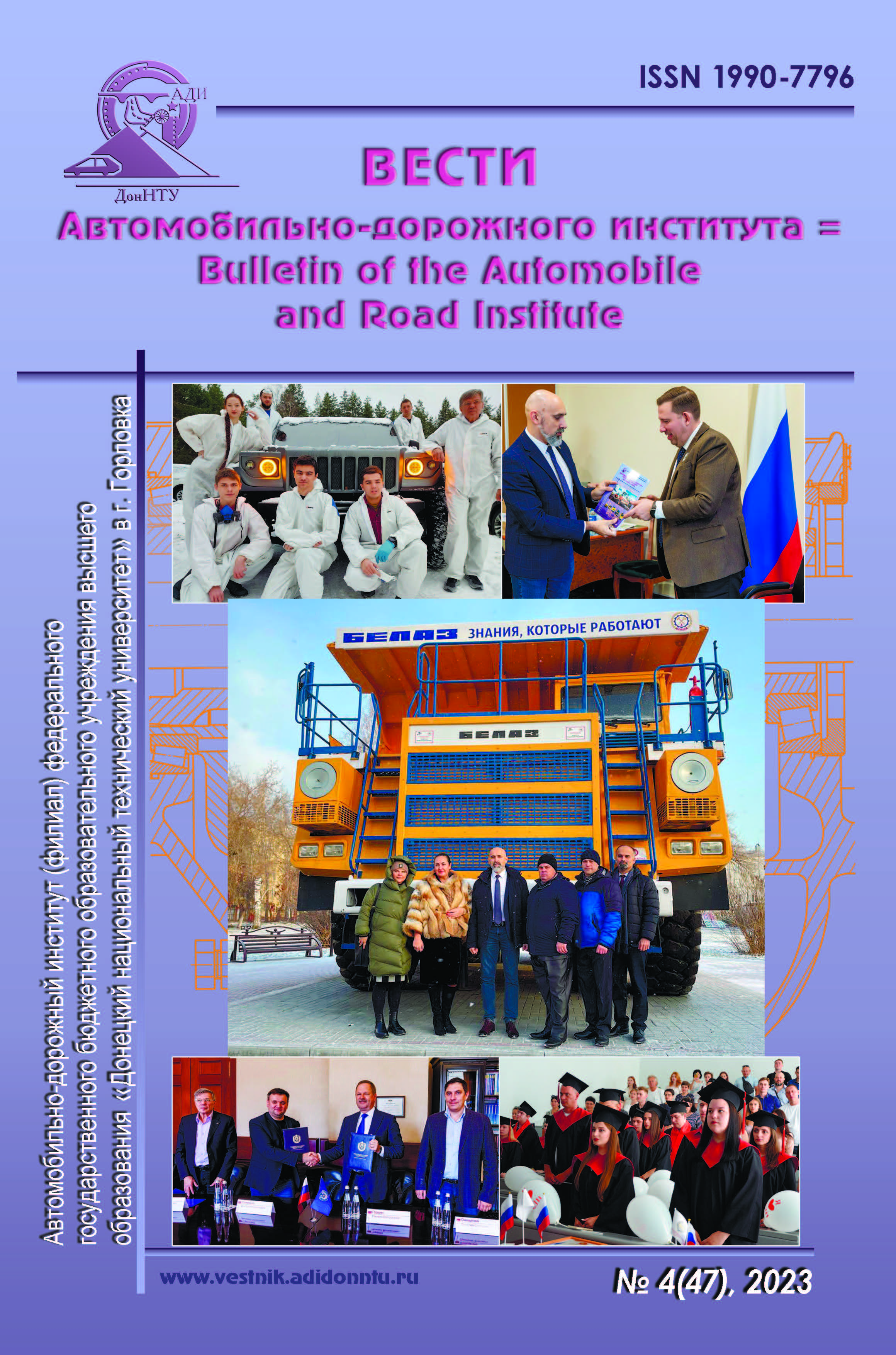Analysis of the Road Transport Impact on the Environmental State of Urban Agglomerations
Keywords:
ENVIRONMENT, URBAN AGGLOMERATION, ENVIRONMENTAL SUSTAINABILITY, TRANSPORT CLUSTER, ROLLING STOCK, VEHICLE OPERATION, EXPERT ASSESSMENTAbstract
The article considers the rolling stock as a physical multi-level object that develops natural resources and releases pollutants into the city environment. It is proposed to take the elementary physical particle «Friedmon» as an analogue of this object. The relationship for assessing the environmental sustainability of a vehicle as a consumer of a «dirty resource» in the city environment is proposed. The dependence of the consumption volume of the «dirty resource» on the operating characteristics of the rolling stock engine is considered. The study of the rolling stock operating conditions in the city environment showed that 80 % of vehicles operate in idling mode outside the normal operating mode of the engine, which causes an increase in emissions of pollutants into the atmosphere and soil.
Using cluster analysis, the assessment of road transport on the environment of the urban agglomeration is made. For this purpose, the city's rolling stock was divided into five main groups: cars, trucks with gasoline engines, trucks with diesel engines, buses with gasoline engines, buses with diesel engines. Based on the results of the cluster analysis, the dependence is proposed that allows us to assess pollutants from the transport cluster in the city environment.
The values of indicators of operational properties of vehicles and the values of their significance coefficients are established by expert means. The main measures of the direct impact on the environmental sustainability are air, water and soil pollution, thermal and noise pollution. The measurements of indirect impact include the traction, speed and braking properties of vehicles, the need for structural and operational materials, labour costs, etc.
References
Орифов, Дж. Р. Влияние загрязняющих веществ автотранспорта на экологию города Душанбе / Дж. Р. Орифов, М. Холмирзоева. – Текст : электронный // Водные ресурсы, энергетика и экология. – 2021. – Т. 1, № 2. – С. 101–103. – URL: http://cawater-info.net/library/rus/
wree-2-2021.pdf .
Оценка влияния автотранспорта на экологию Москвы и здоровье москвичей / С. В. Мхитарян, Р. Р. Сидорчук, И. И. Скоробогатых,
А. В. Лукина // Друкеровский вестник. – 2022. – № 2(46). – С. 143–151.
Кириллов, Н. Г. Экология и автотранспорт: о необходимости перехода на природный газ как перспективное моторное топливо /
Н. Г. Кириллов, А. Н. Лазарев // АвтоГазоЗаправочный комплекс + Альтернативное топливо. – 2015. – № 6(99). – С. 19–27.
Щукина, Т. В. Оценка воздействия автотранспорта на экологию урбанизированных территорий и пути сокращения нагрузки транспортной системы мегаполиса / Т. В. Щукина, О. С. Тамонова, И. И. Акулова // Экология и промышленность России. – 2017. – Т. 21, № 4. – С. 36–41.
Самисько, Д. Н. Проектирование координированного светофорного регулирования на основании компьютерного моделирования движения автомобилей / Д. Н. Самисько // Вести Автомобильно-дорожного института = Bulletin of the Automobile and Highway Institute. – 2020. – № 4(35). – С. 15–23.
Власов, А. А. Математическое обеспечение подсистемы светофорного управления интеллектуальной транспортной системы / А. А. Власов, В. В. Коновалов. – Текст : электронный // Мир транспорта и технологических машин. – 2023. – № 3-3(82). – С. 68–74. –
URL: https://oreluniver.ru/public/file/archive/mtitm_dlya_sayta_ZHURNAL__3-3(82).pdf .
Данович, Л. М. Прогнозирование исходных данных в динамическом режиме для модели распределения транспортных потоков по сети / Л. М. Данович, Н. А. Наумова. – Текст : электронный // Фундаментальные исследования. – 2016. – № 9-2. – С. 238–242. – URL: https://s.fundamental-research.ru/pdf/2016/9-2/40727.pdf .
Болодурина, И. П. Интеллектуальная модель прогнозирования интенсивности движения транспортных средств на перекрестке /
И. П. Болодурина, Л. М. Анциферова, Л. С. Гришина. – Текст : электронный // Интеллект. Инновации. Инвестиции. – 2022. – № 6. – С. 69–78. – URL: https://cyberleninka.ru/article/n/intellektualnaya-model-prognozirovaniya-intensivnosti-dvizheniya-transportnyh-sredstv-na-perekrestke/viewer .
Бочкаева, Г. Л. Роль транспортного кластера в социально-экономическом развитии регионов / Г. Л. Бочкаева. – Текст : электронный // Вестник Московского гуманитарно-экономического института. – 2018. – № 2. – С. 5–11. – URL: https://www.miit.ru/content/%D0%9F%D1%80%D0%BE%D0%B3%D0%BD%D0%BE%D0%B7%D0%B8%D1%80%D0%BE%D0%B2%D0%B0%D0%BD%D0%B8%D0%B5%20%D0%B4%D0%B8%D0%BD%D0%B0%D0%BC%D0%B8%D1%87%D0%B5%D1%81%D0%BA%D0%B8%D1%85%20%D1%81%D0%B8%D1%81%D1%82%D0%B5%D0%BC.pdf?id_wm=801885 .
Stathopoulos, A. A multivariate state space approach for urban traffic flow modeling and prediction / A. Stathopoulos, M. Karlftis // Transportation Research Part C: Emerging Technologies. – 2003. – Vol. 11, № 2. – P. 121–135.
Edussuriya, Pr. Urban morphology and air quality in dense residential environments: Correlations between morphological parameters and air pollution at street-level / Pr. Edussuriya, A. Chan, A. Malvin // Journal of Engineering Science and Technology. – 2014. – Vol. 9, № 1. – P. 64–80.


